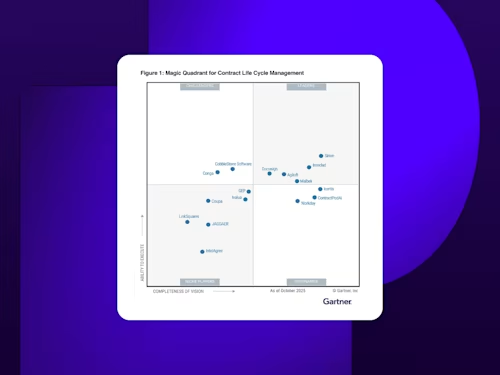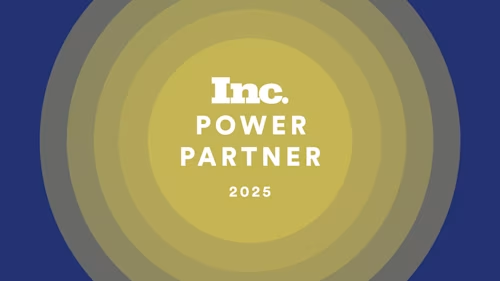
Contract Management Trends for 2025: Generative AI, Agents and More
From generative AI to agents, let’s explore the key trends that will shape the future of contract management in 2025 and beyond.

As the demands of modern business accelerate, contract lifecycle management (CLM) is rapidly evolving. We now have CLM platforms that integrate seamlessly into existing systems and deliver mobile-friendly solutions for on-the-go decision-making. The next wave of advancements, including contextual intelligence and agentic AI, will make CLM even more effective at mitigating risk, enhancing compliance, automating routine tasks, and leveraging predictive insights to close deals faster.
Let’s explore the key trends that will shape the future of contract management in 2025 and beyond.
Reimagine agreement processes with generative AI
Generative AI is undoubtedly a game changer for many areas of business. The challenge for agreement professionals is correctly using AI to drive business value. You don’t find a hammer and go searching for a nail–you have to ensure you have the right tool for the job. Likewise, with generative AI, you have to start with the problem to ensure generative AI is the right tool to solve it.
Today, significant opportunities exist for generative AI to add even more value in the contract process, including:
Summarizing content to make it more easily digestible
Highlighting key points and phrases of an agreement
Searching a repository for specific language within documents
Setting up renewal reminders or other activity notifications
Auto-tagging agreement metadata
As generative AI continues to advance, it will soon be clear which AI solutions are fit for purpose. Trying to negotiate counterparty paper more efficiently and effectively to your standards? AI performs well. Trying to create a complex agreement from scratch consistently down to the letter of your compliance standards? It cannot do this well on its own–yet. Investing in solutions accordingly will differentiate successful businesses from those that hit the trough of disillusionment.
Have your CLM meet you where you work
Historically, CLM customers have been forced to use a variety of systems to manage their agreement processes. Whether in quote-to-cash, procure-to-pay, or hire-to-retire processes, users previously had to leave their workflows to manage agreements.
In 2025, customers expect the benefits of CLM to meet them on the platforms they use every day. Embedded experiences delivered through increased connectivity mean that agreement data can flow freely–from key systems like ERP and CRM to CLM and vice versa. This ensures users can leverage enhanced agreement data and processes without ever leaving their key platforms and disrupting workflows.
Access agreements (and their data) on the go
As the pace of business accelerates, we increasingly need to work on the go. To stay competitive, technology solutions need to be equally mobile. By extending key features and capabilities to mobile devices, vendors empower users to work seamlessly between desktop and mobile interfaces.
While you may not want to draft an entire agreement on your phone, you certainly could get view agreement approval data and risk factors to decide whether you can approve and sign on the go. When users are enabled to move faster from anywhere, business becomes more efficient and competitive.
Leverage AI to generate agreements and playbooks
For a while now, it has been possible to prompt a large language model (LLM) to create an agreement. While this technology has shown tremendous progress, there are many questions about its real-world ability to deliver compliant, consistent agreement content. Consistency in standards and specific language are key to minimizing risk, particularly for legal departments and contract managers.
With the state of this technology in 2025, companies will have to determine how to balance the tradeoffs between compliance, consistency and the increased efficiency of leveraging these tools. Certainly, there will be simple, low-risk agreements where such tradeoffs may be perfectly acceptable. But as complexity and risk increase, the tradeoff becomes less clear. Determining where and when to leverage these capabilities will be a challenge for both vendors and consumers alike for agreement generation. Another process that can be transformed by AI is the creation of legal playbooks. Playbooks are essential tools for ensuring contract reviews are conducted consistently and in compliance with a company's standards, policies, and risk tolerance. Intended to provide structured guidelines on key contract terms, negotiation positions, and fallback provisions, playbooks help teams make faster, more informed decisions.
Traditionally, creating playbooks has been a time-consuming process requiring extensive manual effort. However, generative AI is transforming this process by analyzing a company’s standard agreement templates and historical negotiations to generate tailored playbooks automatically. AI-powered tools can identify common clauses, suggest optimal language, and flag areas requiring special attention, significantly accelerating the development and maintenance of legal playbooks. This not only enhances efficiency but also ensures contract reviews remain aligned with evolving business and regulatory requirements.
Gain insights on agreements with context
Agreement professionals know that managing risk and compliance across parties and agreement types is always contextual. Put simply, low-risk, compliant language in one agreement may be high-risk, non-compliant language in another. For solutions to advance beyond information and provide meaningful intelligence, they need to offer dynamic insights reflecting the nuances of each agreement and party based on historical and contextual insights.
The next horizon is agreement platforms that incorporate historical data, user behavior, and third-party inputs to make smart recommendations. Whether generating compliant agreements for specific parties or surfacing insights across an entire portfolio, customers need solutions with contextual intelligence to transform the way they work, not simply offer more data. This, of course, further enhances core functions like SLA compliance, obligation management, and entitlements. Leveraging contextual intelligence with data from integrated business systems like CRM and ERP will become the optimized agreement management platform that the market craves.
For example, a standard, internal vendor agreement playbook may not suffice if confronted with additional, external data suggesting that doing business with that vendor carries additional risk. Marrying this type of data in a single point of view, will dramatically enhance productivity and create a better experience for agreement professionals.
Prepare for the age of Agentic AI
Agentic AI (AI systems designed to act autonomously) is poised to revolutionize contract management by automating complex, time-consuming tasks and enhancing decision-making capabilities. And some of these capabilities are already here. While we may not be ready to hand over all aspects of the contract management process to AI, agentic AI is already streamlining processes by automating routine tasks such as contract drafting, clause selection, and initial reviews. This allows users to significantly reduce the time spent on manual work by identifying potential risks, ensuring compliance, and flagging errors or inconsistencies in real time. Human oversight is typically still required as these nascent tools are still maturing, but this is a huge leap forward that will continue to grow in 2025. Furthermore, agentic AI has the ability to leverage predictive analytics to anticipate contract outcomes, optimize renewal processes, and suggest improvements to existing language and contract templates based on historical data. By proposing optimized terms and identifying mutually beneficial solutions, agentic AI accelerates deal closures and reduces the burden of manual review. This shift leads to greater efficiency, lower costs, risk reduction, and improved accuracy – enabling legal and business teams to focus on strategy, innovation, and long-term growth.
Want to see how we’re transforming agreement processes with AI? Learn more about Intelligent Agreement Management.
Krysta Johnson is a senior legal operations evangelist at Docusign.
Related posts
Docusign IAM is the agreement platform your business needs



